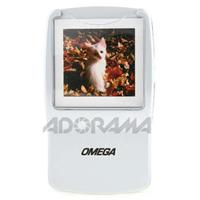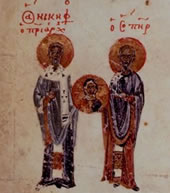The Art to Go Bag sells for $150 @ the J. Paul Getty Museum Store and pairs well with this high-tech 35-mm viewer, which might even be mistaken for a previous generation ipod.

twitter: meganmacken
Director, Visual Resources Center and Digital Media Archive, Division of the Humanities, The University of Chicago.
My academic background ranges from classics and comparative literature to modern art and architectural history, and so, naturally, I am a librarian. I have graduate degrees in art history and library science, manage digital image and audio collections for the Division of the Humanities, and am always eager to collaborate across disciplines, universities, and even continents! I'm interested in exploring the library's role in Digital Humanities, not just as an archive for born-digital objects but as a locus for Digital Humanities centers. At THATCamp I'm excited to find out how others are visualizing data, especially to facilitate creative research and teaching in art and architectural history and film studies. How can visual data (still images, film, 3D models, etc) move beyond illustration and become a source for research? What kind of creative information retrieval interfaces do we need to do this? We've got metadata...let's make it work!
The Art to Go Bag sells for $150 @ the J. Paul Getty Museum Store and pairs well with this high-tech 35-mm viewer, which might even be mistaken for a previous generation ipod.

What’s the easiest way to share images from LUNA and ARTstor?
Create a link.
LUNA’s Share This feature creates a link for whatever you’re looking at: one image, a group of images, search results, or even a presentation. Just click Share This in the window you want to share. Copy the link and paste into an email or Chalk. For details, see LUNA Help.
ARTstor has a similar feature. Select the image thumbnail or view the image group you want to share. Click Generate image url in the Share menu. For full details, see ARTstor Help.
New from the British Library is the Digitised Manuscripts Blog by Juan Garcés, project manager of the Greek Manuscripts Digitisation Project. Funded by the Stavros Niarchos Foundation, the project will digitize 250 Greek manuscripts of the British Library’s 1,000 Greek codices and 3,000 Greek papyri by summer 2010.

The VRC will be closed from December 14th through December 30th for building improvements. The VRC will reopen in CWAC 261 on Thursday, December 31st.
Although the digital imaging lab will be closed, VRC staff will be available for questions during this time. Please contact us at visualresources@uchicago.edu.
How would you rate this image?
James Z. Wang, associate professor of information sciences and technology, is one of the principal researchers on the Aesthetic Quality Inference Engine (ACQUINE), a system that judges the aesthetic quality of digital images. Wang said this tool is a significant first step in recognizing human emotional reaction to visual stimulus.
ACQUINE, which has been in development since 2005 and was launched in April 2009, can be found online at http://acquine.alipr.com. Users can upload their own images for rating or test the system by providing a link to any image online. The system provides an aesthetic rating within seconds. more…
If you are sure everything is connected correctly, and you have turned on the laptop only after everything else is connected and turned on, you may need to use a keyboard command to tell the laptop something is connected to its external output port. Below is a fairly comprehensive list of keyboard commands as provided by the manufacturers, compiled by Extron Electronics and edited by United Visual:
Are you using Powerpoint on a Mac? If so, you can easily load a folder of images into a presentation with just a few clicks. The VRC can install this simple program for you. Just contact us for more information.
The Visual Resources Association (VRA) recently honored Amanda Rybin, our new Image Cataloger, with a Tansey Travel Award. This award will support Amanda’s attendance at the VRA’s 27th Annual Conference in Toronto in March. Congrats, Amanda!
Looking for digital images for your papers, presentations or art history tests? ARTstor contains nearly one million images gathered from museums, universities, libraries, and the U of C’s Visual Resources Collection.
ARTstor for Undergrads
ARTstor for Faculty and Graduate Students
LUNA, the VRC’s new Web-based image delivery system, is now available with over 165,000 images.
LUNA allows you to search image collections, manipulate images, and create image-based presentations ideal for classroom and professional use. Zoom in and crop high-resolution images and quickly share your content as a hyperlink. Individual images can also be exported to other presentation software, such as PowerPoint and Keynote.
Click here to learn more.